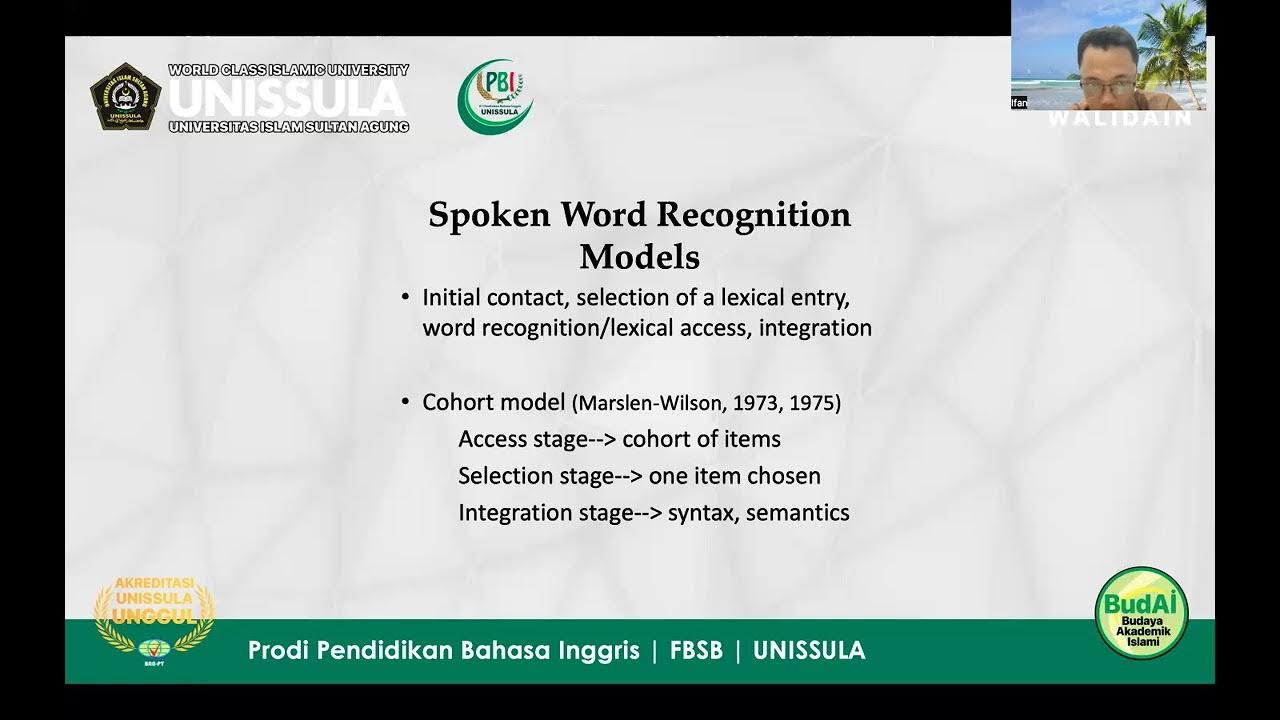2nd Language Theories and Perspectives
Summary
TLDRIn this video, Camilla, a third-year TOEFL student, explores the various theories of second language acquisition. She discusses behaviorism, Chomsky's innate knowledge theory, the cognitive perspective, and socio-cultural approaches, highlighting how each framework informs language learning. Key concepts include Krashen's monitor model, the interaction hypothesis, and the role of cognitive processing in fluency. The video underscores the complexity of language acquisition, emphasizing that no single theory can fully explain the process, which varies based on individual learners' experiences and contexts.
Takeaways
- 😀 Behaviorism emphasizes imitation, practice, and habit formation in language learning.
- 😀 Chomsky's innate knowledge theory suggests that children are naturally programmed to acquire language.
- 😀 Krashen's Monitor Model outlines five hypotheses explaining how language is acquired, including the importance of comprehensible input.
- 😀 The cognitive perspective compares language acquisition to information processing in computers, emphasizing attention and practice.
- 😀 Usage-based learning highlights the significance of frequency and context in learning language features.
- 😀 The competition model emphasizes the importance of learning different linguistic cues and understanding meaning over structure.
- 😀 The interaction hypothesis stresses the necessity of conversational interaction for second language acquisition.
- 😀 The noticing hypothesis argues that awareness of language features is crucial for growth in language knowledge.
- 😀 The processability theory indicates that learners find certain language structures easier to process based on their position in sentences.
- 😀 The socio-cultural perspective underscores the role of interaction within the Zone of Proximal Development in constructing linguistic knowledge.
Q & A
What is the behaviorist perspective on language learning?
-The behaviorist perspective posits that humans learn languages by imitating, practicing, and forming habits, similar to findings from experiments with animals.
How was the behaviorist approach applied in language teaching during the mid-20th century?
-During the 1940s to 1970s, behaviorism influenced language teaching with methods focusing on mimicry and memorization, such as auto-lingual teaching materials.
What is Noam Chomsky's contribution to the understanding of language acquisition?
-Chomsky proposed the idea of universal grammar, suggesting that children are innately programmed to acquire language during a critical developmental period.
What limitations exist in applying universal grammar to second language acquisition?
-Universal grammar may explain first language acquisition but does not adequately address second language learning, especially for older learners past the critical period.
What is Stephen Krashen's Monitor Model?
-Krashen's Monitor Model includes five hypotheses about language acquisition, emphasizing that language is acquired through exposure rather than conscious learning.
What does the comprehensible input hypothesis suggest?
-The comprehensible input hypothesis states that language acquisition occurs when learners are exposed to language that they can understand, even if it contains unknown elements.
What role does cognitive psychology play in language acquisition?
-Cognitive psychology views language acquisition as a process similar to information processing, where learners build up knowledge that can become automatic through practice.
What is the interaction hypothesis in second language acquisition?
-The interaction hypothesis argues that conversational interaction is crucial for language acquisition, as it helps make input comprehensible through modifications like clarification and simplification.
How does the socio-cultural perspective explain language learning?
-The socio-cultural perspective views language learning as an internalization process that occurs through interactions within the learner's zone of proximal development.
What is the significance of collaborative dialogue in language learning according to the socio-cultural theory?
-Collaborative dialogue allows learners to construct linguistic knowledge while engaging in tasks, emphasizing the importance of interaction for effective language production.
Outlines

このセクションは有料ユーザー限定です。 アクセスするには、アップグレードをお願いします。
今すぐアップグレードMindmap

このセクションは有料ユーザー限定です。 アクセスするには、アップグレードをお願いします。
今すぐアップグレードKeywords

このセクションは有料ユーザー限定です。 アクセスするには、アップグレードをお願いします。
今すぐアップグレードHighlights

このセクションは有料ユーザー限定です。 アクセスするには、アップグレードをお願いします。
今すぐアップグレードTranscripts

このセクションは有料ユーザー限定です。 アクセスするには、アップグレードをお願いします。
今すぐアップグレード関連動画をさらに表示

Unit 1. Lesson 5 Principles and Procedures in Materials Development

TEAL_2 Understanding Language Acquisition

Individual differences in 2nd language

Krashen's Theory of Second Language Acquisition

The 9 Essential Terms of Second Language Acquisition | Science Behind Language Learning

Learning Theories 2022 | Behaviorism | Cognitivism | Constructivism |
5.0 / 5 (0 votes)
